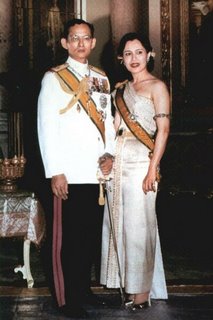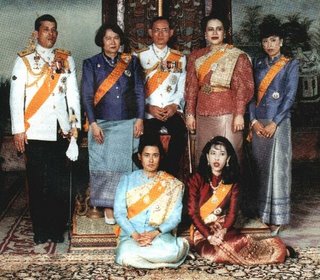 For much of their history, which goes back longer than 700 years, Siamese kings maintained a healthy distance from the demands of foreign conquerors. Thailand retained its autonomy throughout history claiming the distinction of being the only un-colonized country in Southeast Asia.
Following a peaceful coup in 1932, the Kingdom became a constitutional monarchy and some time later it changed its name from Siam, "the land of the White Elephant" to Thailand, “the land of the Free”.
For much of their history, which goes back longer than 700 years, Siamese kings maintained a healthy distance from the demands of foreign conquerors. Thailand retained its autonomy throughout history claiming the distinction of being the only un-colonized country in Southeast Asia.
Following a peaceful coup in 1932, the Kingdom became a constitutional monarchy and some time later it changed its name from Siam, "the land of the White Elephant" to Thailand, “the land of the Free”.
For several disturbing decades, Thailand was hindered by turbulent clashes, offenses and military dictatorships. In the mid 1990’s, however, Thailand managed to be re-born from its ashes emerging into the reasonably stable and economically thriving nation it is today.
His Majesty King Bhumibol Adulyadej -- Rama IX -- along with his consort, Queen Sirikit, have shared Thailand’s royal throne for the past sixty years. They stand as the longest reigning sovereign monarchs in the world conveying unwavering harmony while infusing the kingdom with compelling vitality pertinent to current times.
This past June, massive celebrations to commemorate the 60 years of the King’s ascension to the throne, clearly illustrated the extraordinary outburst of public pride, personal emotion and affection for the 79 year-old, much-revered monarch. Much loved by his people, the king has shown personal affinity for rural and urban issues, maintaining that agriculture will always be the basis of this land.

World dignitaries and royalty from twenty-nine countries gathered in Bangkok for the Monarch’s Diamond Jubilee and were treated to view the Royal Barge Procession along the city’s major waterway, the Chao Phraya River.
The unique Thai Royal barges cruising along the “River of Kings”, is an ancient tradition revived by King Bhumibol in the late 1950’s. This type of barge procession is reserved for very special occasions and the one in June 2006 was the grandest and most regal of all; 2,000 Royal Navy rowers and 52 royal barges were included in the special ceremony.
King Bhumibol Adulyadej succeeded the throne of Thailand in June 1946, at the age of 19, being the ninth ruler of the Chakri Dynasty established in 1782.
Called the “Builder of the Nation”, King Bhumibol -- who has shown deep concern for his country’s inequalities -- has worked tirelessly to guide Thailand into the 21st century with an approach that is eco-sensitive and fair to the rural population.
Multi tasking on his agricultural projects, His Majesty’s astute vision has been recognized internationally and has carried Thailand into an important manufacturing mode.
King Bhumibol has sponsored infinite projects and overseen experiments in re-forestation, irrigation, land development and farm technology; He calls these projects “Living Museums”. Deforested areas a decade ago have now given way to arable farmland; restoration of the ecological balance is the country’s most urgent priority in rural development.
The King of Thailand is an avid reader and is also known as “The Literary King” because his works provide observant principles and philosophies akin to his “Living Museums” reflecting his ideas for technical innovation and rural development.
Providing inspiration to millions, the published royal literary works often discuss aspects of gratefulness, kindness and perseverance as essential values for living. Most of the royal stories offer motivation to a society burdened with increasingly expanding disparities in economic and social status.
King Bhumibol is viewed as the “Father of the Country” and accordingly, Father’s Day in Thailand is celebrated on the monarch’s birthday, December 5, every year.
Offering assistance through the network of various charitable foundations under His sponsorship, His Majesty the King has provided moral support and encouragement to people in rural expansion projects designed to improve their livelihoods.
Wholly devoted to a democratic kingdom, Bhumibol Adulyadej is a loyal defender of its principles in the government of Thailand. His tenacity and devotion for his subjects’ welfare have greatly added to the political stability and economic growth that Thailand has enjoyed over the past six decades.
The King’s observations clearly reveal him as a caring, rounded humanitarian who fervently voices that … “I cannot impose my ideas on the people, I can only suggest”. “Persuade, never impose. And while pursuing material security people need to strive for inner peace of mind through spiritual purification; development must respect the diversity of regional geography and different ways of life”.
The people of Thailand regard their beloved King Bhumibol as the soul of the Thai Kingdom, a man who has truly earned their reverence.
Long Live the King! @Edie Wilcox, 07/06
Latest: September 25 2006
Unfortunately, one week ago, on September 19, the Royal Thai Army staged a coup against the government of Prime Minister Thaksin Shinawatra. The coup, which was Thailand’s first in fifteen years, followed a year-long political crisis involving Mr. Thaksin and political opponents and occurred less than a month before elections were scheduled to be held, on October 15. These elections had however already been postponed, and were likely to be held late in November. The military cancelled the upcoming elections, suspended the constitution, dissolved Parliament, banned protests and all political activities, suppressed and censored the media, declared martial law, and arrested Cabinet members. The coup was bloodless, with there were no casualties.
It has been reported that King Bhumibol has endorsed the coup because the political state of affairs was about to spark off into aggression. With the military government in place and no demonstrations permitted, the feeling is that much violence has been averted.
Life goes on as usual here and except for a few military tanks and some soldiers on the highways, nothing seems out of the ordinary.

 entury, when Chinese and Japanese mass-produced silks hit the marketplace, the rather small Thai silk cottage industry declined profoundly.
entury, when Chinese and Japanese mass-produced silks hit the marketplace, the rather small Thai silk cottage industry declined profoundly. ave become legendary and romanticized all over Thailand. The resurrection of the silk industry; the enterprising, heirless business corporation left behind, plus an affluent traditional teak home -- now a museum of priceless Southeast Asian arts -- the Jim Thompson spirit lives on. The Thai Silk Company Ltd. has branch stores all over Southeast Asia as well as Europe and the USA.
ave become legendary and romanticized all over Thailand. The resurrection of the silk industry; the enterprising, heirless business corporation left behind, plus an affluent traditional teak home -- now a museum of priceless Southeast Asian arts -- the Jim Thompson spirit lives on. The Thai Silk Company Ltd. has branch stores all over Southeast Asia as well as Europe and the USA.
 Early last year we visited some of the mountainous hill-tribe areas of northern Thailand; the chilly, dry weather was a welcome blessing after living in tropical Bangkok for several months.
The various ethnic minorities scattered along the hills intrigued me, for they have preserved their own language, spiritual beliefs, distinct culture, and colorful style of dress.
Early last year we visited some of the mountainous hill-tribe areas of northern Thailand; the chilly, dry weather was a welcome blessing after living in tropical Bangkok for several months.
The various ethnic minorities scattered along the hills intrigued me, for they have preserved their own language, spiritual beliefs, distinct culture, and colorful style of dress.

















